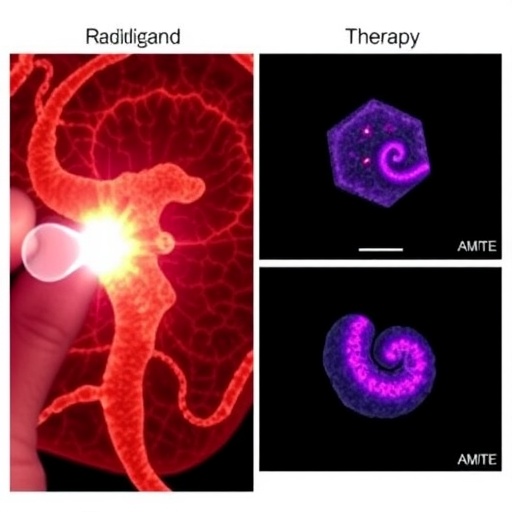In the evolving landscape of oncology, the treatment of gastroenteropancreatic neuroendocrine tumors (GEP-NETs) remains a crucial challenge. Understanding the mechanisms and advancements in treatment modalities can greatly influence patient outcomes. A novel therapeutic approach gaining traction is radioligand therapy (RLT), a treatment that utilizes targeted radiolabeled molecules to deliver radiation directly to cancer cells. This innovative strategy not only enhances the efficacy of cancer treatments but also minimizes damage to healthy tissues, thus offering a more favorable safety profile.
The insights drawn from recent studies reveal that RLT has become an indispensable tool in the management of GEP-NETs. This particular area of research has been notably emphasized in a viewpoint by experts in the field, highlighting its pivotal role in transforming therapeutic protocols for patients suffering from these challenging tumors. With an increasing body of evidence supporting its use, RLT stands at the forefront of personalized medicine, emphasizing a tailored approach that aligns with the unique biological characteristics of the tumors.
Experts from Italy have shared their opinions on the role of RLT in the treatment of GEP-NETs, offering valuable perspectives on the current state of this innovative therapy. The consensus is emerging that RLT presents a significant improvement over traditional treatments, allowing for precise targeting of malignant cells while reducing systemic exposure to harmful radiation. This precision not only leads to improved patient outcomes but also reflects the promise of nuclear medicine in oncology.
One notable advantage of RLT is its dual-action mechanism: it not only delivers significant doses of radiation directly to tumor cells but also promotes local immune responses that could potentially lead to systemic antitumor effects. The integration of such therapy into standard treatment protocols is a significant development, as clinical trials continue to demonstrate its effectiveness and safety. The commitment of the medical community in Italy to this approach is underscored by the growing number of studies supporting its implementation.
Moreover, the pharmacokinetics of the radioligand compounds are vital to the therapy’s success. Understanding how these compounds interact with neuroendocrine tumor cells aids in optimizing dosimetry and treatment scheduling, ultimately improving patient management. The discussions among Italian experts reflect an understanding of these nuances and advocate for the continuous evolution of therapeutic strategies based on emerging data.
Furthermore, the advancement of imaging techniques used to monitor treatment response is another critical component that enhances RLT’s efficacy in GEP-NET management. Sophisticated imaging modalities such as PET/CT and SPECT provide real-time data about tumor activity and the effectiveness of radioligand therapy. This ability to visualize tumor dynamics is revolutionizing how oncologists tailor treatments to the individual needs of their patients.
As the article emphasizes, the synergy between RLT and other treatment modalities, such as surgery and systemic therapies, highlights the importance of a multidisciplinary approach in the management of GEP-NETs. This integrative strategy ensures that all potential benefits are explored, giving patients a comprehensive treatment plan that maximizes their chances of long-term survival.
The landscape of cancer treatment is rapidly changing, yet the challenges faced by patients with GEP-NETs remain significant. The introduction of RLT signals a pivotal shift toward more personalized and effective treatment options. As research continues to evolve, the therapeutic options available to patients are expected to broaden, offering hope to many who have faced limited choices in the past.
Patient advocates have also begun to recognize the potential impact of these advancements on quality of life. RLT not only aims to prolong survival but also aspires to do so while minimizing the adverse effects associated with traditional radiotherapy. Consequently, the qualitative aspects of patient care are taking center stage in discussions surrounding cancer therapies.
The Italian expert opinion piece calls attention to the importance of regulatory pathways and collaborative research initiatives to further expedite the approval and clinical implementation of RLT. This framework is crucial not only for advancing scientific knowledge but also for ensuring that patients have timely access to innovative therapies that can make a meaningful difference in their treatment outcomes.
In conclusion, the role of radioligand therapy in gastroenteropancreatic neuroendocrine tumors is a promising area of research that is positioned to reshape treatment protocols and improve patient outcomes significantly. The expert opinions suggest a future where RLT is not only a standard of care but a cornerstone of personalized medicine in oncology. With ongoing clinical trials and research, the full potential of this therapy is yet to be realized, but early indications suggest a transformative impact on how GEP-NETs are managed.
The trajectory of RLT reflects broader trends in oncology towards more innovative, targeted therapies that prioritize patient-centric care. As these advancements continue to unfold, it will be imperative for healthcare professionals, researchers, and advocates to collaborate and ensure that the latest breakthroughs are swiftly translated into practice, ultimately enhancing the lives of those affected by neuroendocrine tumors.
Subject of Research: The role of radioligand therapy in gastroenteropancreatic neuroendocrine tumors
Article Title: The Role of Radioligand Therapy in Gastroenteropancreatic Neuroendocrine Tumors: An Italian Expert Opinion
Article References:
Tafuto, S., Lastoria, S., Panzuto, F. et al. The Role of Radioligand Therapy in Gastroenteropancreatic Neuroendocrine Tumors: An Italian Expert Opinion.
Adv Ther (2025). https://doi.org/10.1007/s12325-025-03383-5
Image Credits: AI Generated
DOI: 10.1007/s12325-025-03383-5
Keywords: Radioligand Therapy, Gastroenteropancreatic Neuroendocrine Tumors, Precision Medicine, Oncology, Treatment Protocols, Clinical Trials
Tags: cancer treatment efficacy improvementschallenges in treating neuroendocrine tumorsexpert opinions on RLTGEP-NETs treatment advancementsinnovative oncology therapiesItaly’s contributions to cancer researchmechanisms of radioligand therapypatient outcomes in neuroendocrine tumor treatmentpersonalized medicine in oncologyradioligand therapy for neuroendocrine tumorssafety profile of radioligand therapytargeted radiolabeled molecules in cancer





